Project Day Learners – Bioelectrical Orientation Workshop
But what is bioelectric orientation?
Bioelectric orientation is an ability of some animals that enables them to perceive their environment with the help of electric fields. This ability is based on special organs called electroreceptors, which can pick up and process electrical signals from the environment. Animals such as the proboscis fish, the elephant trunk fish or the shark can detect prey in this way or locate their enemies, specific locations or their conspecifics. The principle of bioelectric orientation is based on the fact that electric fields generated by objects in the environment are detected by the electroreceptors. These electric fields are created, for example, by the contraction of muscles, which generate electric signals, or by chemical processes that create charge differences. The electroreceptors convert these electrical signals into neural signals that can be processed by the brain. In this way, animals can “see” their environment, even if it is not visually perceptible. For research and technology, bioelectric orientation offers great potential for developing new methods for exploring the environment and developing new technologies. For example, robots can be equipped with electroreceptors to better perceive their environment and perform their tasks more precisely.
Discovering bioelectric orientation through self-awareness
The workshop included a wide variety of tasks in which we were allowed to get hands-on and learn about bioelectrical aspects.
Among other things, the laboratory had two aquariums containing fish with bioelectric capabilities. The proboscis fish has electrosensitive receptors, which are used for orientation in water. This has not been scientifically proven, but it is assumed that this property is due to its habitat. Since the proboscis fish is mainly found in turbid waters, its electrical properties allow it to orient itself without having to use its eyes for visual orientation. In doing so, it regularly emits signals that provide it with a three-dimensional spatial image according to the principle of time-of-flight measurement. The aquariums in the biology laboratory of the Technorama were equipped with electrodes, whose measured signals were visualized with the help of an oscilloscope and displayed on a monitor above the aquarium, as well as played back acoustically via a loudspeaker. When the proboscis fish was lured to the electrode with food, distinctive cracking sounds could be heard.
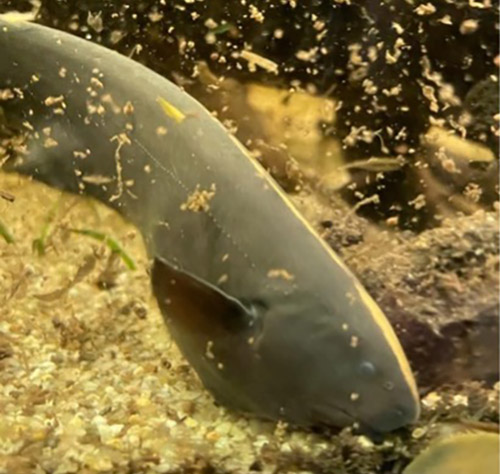
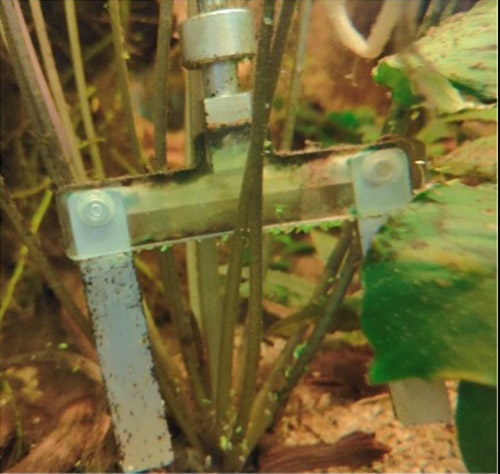
Another exciting experiment illustrated the electrical relationships with the help of natural materials. Oil was poured into a container and semolina was spread on top. Subsequently, a voltage of 10,000 volts was generated with a machine comparable to an induction machine and transferred to the heterogeneous mixture with the aid of electrodes. Consequently, the semolina grains oriented themselves along the electric field lines, which were thus visualized. In addition, we were able to deepen our understanding of the behavior of electric fields by placing various bodies, such as a metal screw, between the electrodes. It was impressive how easy it is to feel electrical voltage.
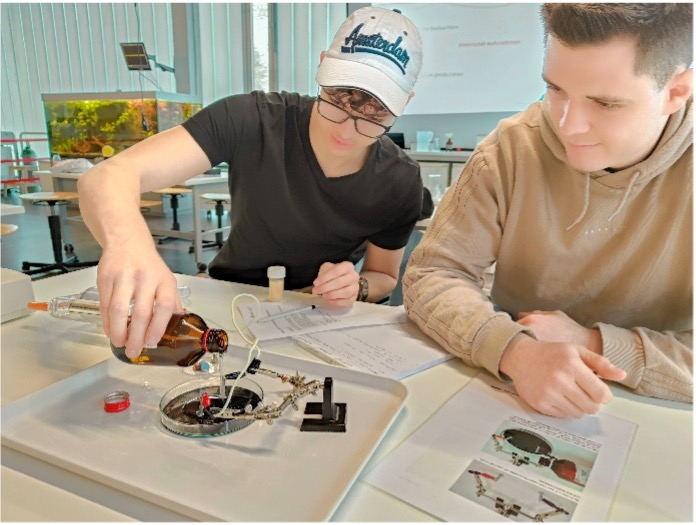
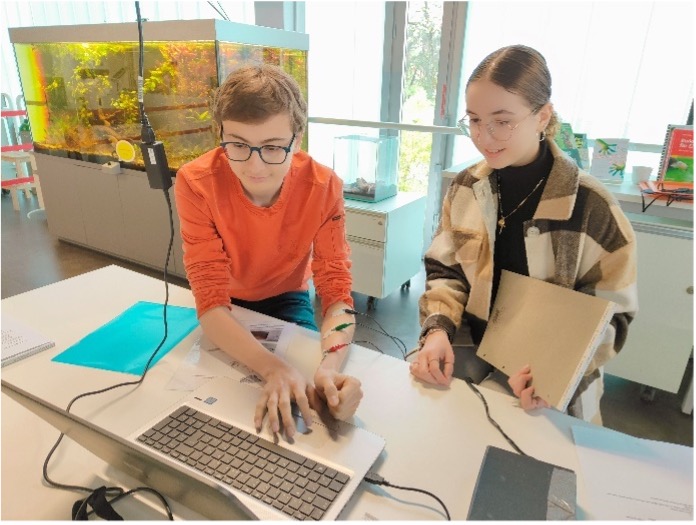
Muscles can be stimulated with the help of tension. This causes the muscles to contract. In the workshop, we were able to experience and feel these effects firsthand. This was possible with the help of batteries.
In another experiment, we were able to measure the tension in the body during muscle contractions using three electrodes on the arm and display it on a screen. When the arm muscle was contracted, the tension increased and when it was relaxed, the tension decreased. When an electrode was attached to the other arm, it was possible to measure the heartbeat, as with an ECG.
Bioelectric orientation and the human being
It was also mentioned that we humans are also able to perceive electric fields, but this ability is not as pronounced in us as it is in the proboscis fish. We were able to experience this first hand by trying, with our eyes closed, to detect the movements made by another learner with a serving tray next to us. This was very difficult and the proof that we do not have the same ability as the proboscis fish, which only orientates itself in this way.
Bioelectrical Orientation and Camille Bauer Metrawatt AG
The question that was on our minds throughout the workshop was, what does Camille Bauer Metrawatt AG have to do with bioelectrical orientation? Answering the question was not easy. Camille Bauer Metrawatt AG produces devices for the visualization of various current variables. Our devices do not produce electricity, so they have little to do with bioelectrical orientation. The PQ-5000 Current Link, which uses Rogowski coils to measure the electromagnetic field, shows us that these electromagnetic fields are present in bioelectricity, but also in ordinary electricity. The proboscis fish can perceive the electric fields itself with special receptors, but we humans need a device, such as the PQ-5000 Current Link, to record such fields. However, even with such excellent devices, we perceive electricity differently than the proboscis fish.
Explore electricity on your own and much more
After the workshop, we had time to visit the Technorama exhibition. This was very impressive and offered a variety of interactive exhibits and experiments that brought the world of physics and technology to life. The exhibits on optics, mechanics, and electrical engineering were particularly interesting, as it offered a wide assortment of experiments, all of which we tried. The optical illusions exhibit was very impressive, as we could not explain exactly how such an illusion works and why, that our eye deceives us like that. It was also impressive to see what an atom looks like and how it can be made visible. We were all amazed at the size of the atom.
All in all, the project day at Camille Bauer Metrawatt AG was a great success. We had the opportunity to deepen our knowledge of bioelectrical orientation, to perform many experiments on it and to discover the fascinating world of physics and technology at Technorama. We would like to thank Camille Bauer Metrawatt AG and especially Mrs. Romina Widmer for organizing this day.
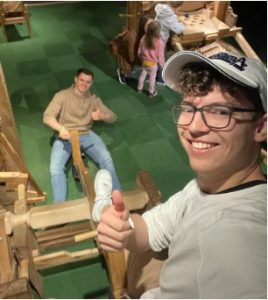
Author
Apprentices of Camille Bauer Metrawatt AG
